Nepal a small yet warm-hearted country and the people of this country are really simple and welcoming. If we talk about the history so Nepal is the only country who never came under the British Empire. The traditions and culture of Nepal are reminiscent of its massive neighbours, India and China; this tiny mountainous kingdom has a distinct culture and history.
Surrounded by the majestic Himalayas on all sides, Nepal certainly abounds in pristine natural beauty. Be it the snow-capped peaks of the Himalayan ranges or the tranquil valleys, most of Nepal looks just like an image turned reality from your childhood fairy-tale book.
Apart from that, the country has plenty to offer to the cultural traveller. Being a melting pot of Buddhist and Hindu ideologies, Nepal has a rich history that is unique and enchanting. From massive Hindu temples to quaint Buddhist monasteries and architectural masterpieces, Nepal has it all.
The best thing – a large number of Nepal’s top-rated cultural and historical attractions are located in and around Kathmandu, the capital city, making them highly accessible for visitors.
Let’s explore the famous historical places of Nepal:
15 Most Famous Historical Places of Nepal
- Durbar Square
- Shree Pashupatinath Temple
- Bhoudanath Stupa
- Changu Narayan Temple
- Lumbini
- Patan Durbar Square
- Swayambhunath Stupa
- Kathmandu Durbar Square
- Janakpur
- Muktinath Temple
- Mustang Caves
- Janaki Mandir
- Kopan Monastery
- Complex of Ruru Kshetra
- Sagarmatha National Park
1. Bhaktapur Durbar Square
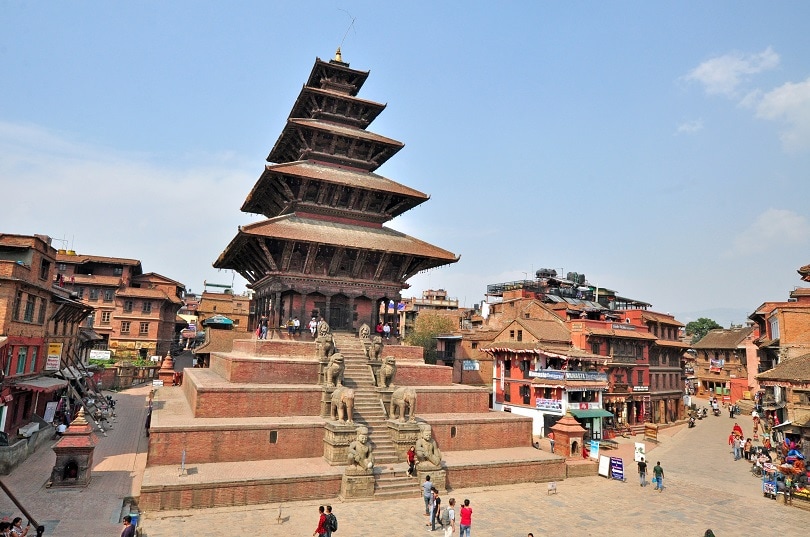
Located at a distance of just 15kms (or 10 miles) to the east of the capital city, Bhaktapur is an excellent option for a day or weekend trip from Kathmandu. A UNESCO world cultural heritage site, the Durbar Square (Royal Plaza) is the epicentre of this ancient Newari city.
The square is indeed a living museum. You can see plenty of ancient monuments, buildings, and temples where ever you turn. If the weather cooperates, you can experience panoramic views of the Himalayan peaks from Nagarkot, a tiny hill-station village that lies near Bhaktapur. If you get the chance, try a home-stay to experience authentic Nepalese hospitality and you will get to enjoy the flavours of traditional home-cooked meals.
How to Get Here from Kathmandu
The easiest option is to hire a taxi. Though the distance is less than 10 miles, the ride takes around 40-45 minutes, depending on traffic conditions. The taxi costs around 800 NRS, which is roughly equivalent to 7 EUR/8 USD.
The other option is to get on a bus. You can take a local bus or a tourist bus. Local buses are super-cheap but crowded. However, if you want to get a glimpse of the local way of life, then brave the crowds and hop on one. Tourist buses are less crowded. The cost of a ride on a tourist bus from Thamel (the tourist hotspot in Kathmandu) to Bhaktapur Durbar Square is 30 NRS.
Entrance Fee
Foreign National – 1500 NPR
Citizen of a SAARC nation (India, Sri Lanka, Pakistan, Maldives, Bhutan, Bangladesh) or China – 500 NPR
Nepalese Citizens – Free
With your entry ticket, you get a leaflet and a map detailing the attractions and history of the Durbar Square.
Key Attractions
The Durbar Square in Bhaktapur is home to several of the historical monuments of Nepal. The buildings are centuries old, and the architecture is diverse and stunning. It has several tiny alleys and streets that are rich in cultural offerings. Some of the important monuments here include:
55 Windows Palace – This huge monument dominates the entire square and dates back to the 15th century. The statue of King Bhupatindra Malla is seen atop a large column as he offers prayers to the Almighty.
Nyatapola Temple – a massive, 5-storey temple which visitors can climb to get sweeping views of the entire square. It’s the most famous pagoda in all of Nepal and is the highest one. The deity at this temple is Goddess Siddhi Laxmi. The word “Nyatapola” in the local Newari language refers to five tiers, which denote the five elements (air, water, land, fire, and wind).
The Vatsala Temple (sadly this was destroyed in the earthquake of 2015)
Dattatreya Temple, in the Dattatreya Square, adjacent to the Durbar Square
Taumadhi Square
Bhairavanath Temple
Golden Gate and Lion’s Gate
Pottery Square – clay artefacts made by potters are available for sale.
2. Shree Pashupatinath Temple
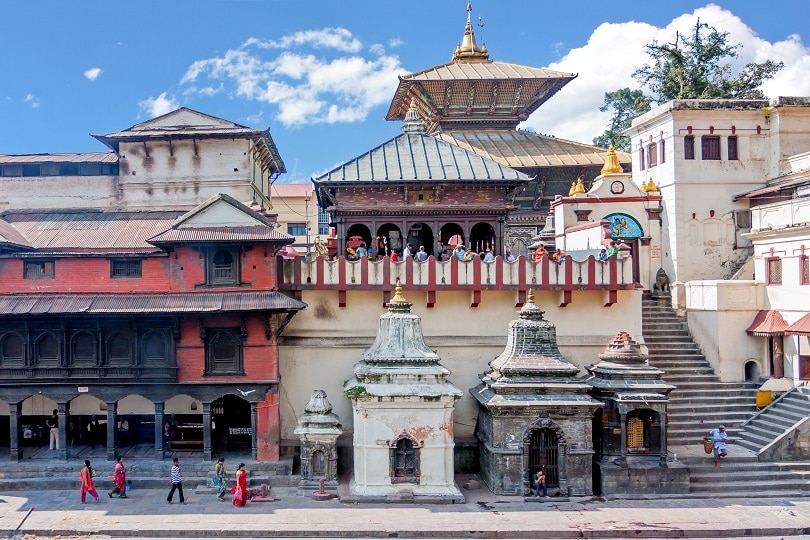
This is the largest Hindu temple in the world devoted to Lord Shiva. It is one of the famous Nepal’s Historical sites and is a UNESCO World Cultural Heritage site. The temple is situated on the banks of the river Bagmati and lies at a distance of 5 kms to the northwest of the capital city Kathmandu.
Shree Pashupatinath temple is often referred to as the “Temple of Living Beings,” as it attracts a vast number of pilgrims every day who come from faraway places to offer their prayers and seek blessings of the divine deity.
Apart from its religious importance, this temple complex is a stunning example of ancient architectural prowess. Shivratriand the Bhagmati riverside are two of the most important event and riverside to watch at this temple.
How to Get Here from Kathmandu:
It’s just a ten-minute drive from the Tribhuvan International airport in Kathmandu. The drive from Thamel or Kathmandu Durbar Square takes around 20 minutes.
Entrance Fee:
Foreign National or SAARC national – 1000 NPR
Nepalese or Indian Citizens – Free
Other Helpful Points:
Best times to visit are from September to November or February to April.
The main temple is open only to Hindus while others can enter the massive temple complex.
The outdoor cremation rites are pungent and you may consider bringing a mask if you’re affected by strong odours.
Since it’s a place of worship, consider wearing clothes that cover your back and shoulders.
3. Bhoudanath Stupa
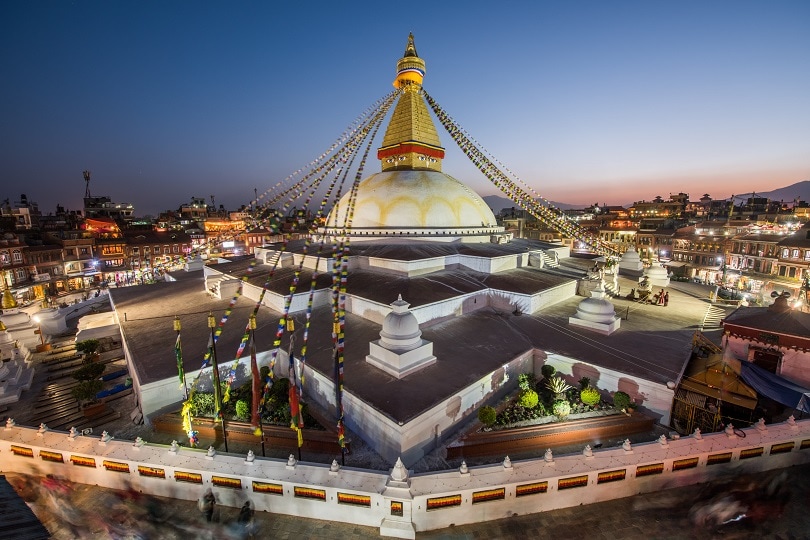
The Bodhnath or Boudhanath Stupa is one of the largest Tibetan Buddhists stupas outside of Tibet. It’s located at a distance of 7 km from Kathmandu and both locals and foreign pilgrims (especially from Tibet) visit this spiritual site. A UNESCO world cultural heritage site, this is one of the top places of Historical Importance in Nepal.
Constructed by King Man Dev in the fifth century, this colossal stupa is built atop an octagonal structure, which symbolizes Buddha’s teachings. It is surrounded by several gompas or smaller temples.
As soon as you enter the complex, the fragrance of incense embraces you and you can hear the prayer wheels creak, as the monks stroll around the base of the stupa. It is open throughout the day.
How to get here from Kathmandu:
The taxi ride from Kathmandu costs around 400 NPR.
Entrance Fee:
Foreign National including Chinese – 400 NPR
Citizen of a SAARC nation – 100 NPR
Nepalese Citizens – Free
Key Attractions:
Hariti/Ajima shrine
Visit Boudhanath at night as it’s illuminated by thousands of candles lit by pilgrims
Follow the monks as they offer prayers at the base of the stupa
Tamang Gompa – that has a huge prayer wheel and a balcony that overlooks the stupa
During the Tibetan New Year, celebrated in Feb or March, Bodhnath hosts the festival of Losar, the biggest Tibetan Buddhist festival in Nepal.
4. Changu Narayan Temple
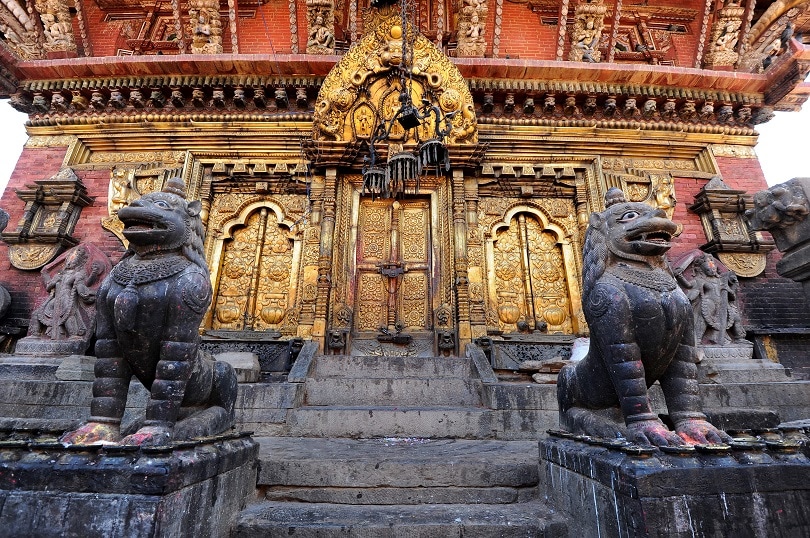
As old as time itself, this ancient Hindu temple has a history that goes back 3000 years. Considered as the oldest Hindu temple in all of Nepal, this one is a UNESCO World Cultural Heritage site and is built in the two-tiered pagoda architectural style that you come across at several places in the Kathmandu valley.
The main shrine is surrounded by mythical beasts – ram-horned griffons, winged lions, and other familiar animals like elephants and lions on all sides. Sadly, a significant portion of this temple complex was affected during the earthquake that rocked Nepal in 2015. However, it’s still open and the damaged areas are under restoration.
How to get here from Kathmandu:
A taxi from Kathmandu costs around 800 NPR, while a taxi from Bhaktapur costs 250 NPR. From Kathmandu, you can get a bus to Bhaktapur and from there, you can get a taxi to this temple.
Entrance Fee:
-
- Foreign Nationals (including Chinese) – 300 NPR
- SAARC Nationals – 100 NPR
- Nepalese – Free
Key Attractions:
The life-sized stone Garuda kneeling in front of Lord Vishnu.
Older sculptures that lie around the temple complex, some dating back to 1500 years ago.
5. Lumbini
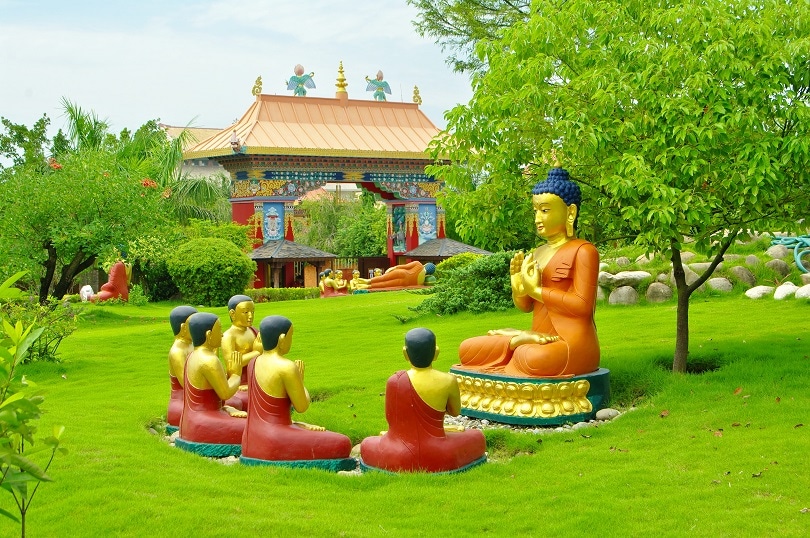
Considered as the birthplace of Siddhartha, who later became Lord Buddha, Lumbini draws hundreds of Buddhist pilgrims daily. In the year 250 BC, the legendary emperor Ashoka erected a stone pillar here marking the birthplace of Buddha.
Maya Devi, the mother of Buddha, gave birth to the Lord near a tree in the centre of the garden, which now houses a temple dedicated to her. Lumbini is around 300 km away from the capital city and makes for a great weekend getaway from Kathmandu. A UNESCO world cultural heritage site, Lumbini is more than just a religious place.
How to get here from Kathmandu:
Take a domestic flight from Tribhuvan airport to Bhairahawa airport in Lumbini. The taxi fare from the airport to the temple is around 1000 NPR. Private tourist buses run between Kathmandu and Lumbini with a journey time of 9 to 10 hours.
Entrance Fee:
Foreign Nationals – 200 NPR
SAARC Nationals apart from Indians – 100NPR
Indians – 16 NPR
Nepalese – Free
Key Attractions:
The park in the temple complex designed by Kenzo Tange, a famous Japanese architect.
The museum and research centre for Buddhism (closed on Tuesdays).
World Peace Pagoda, Lumbini Garden, Thai Monastery, Maya Devi Temple, Dharmaswami Buddhist Monastery.
6. Patan Durbar Square
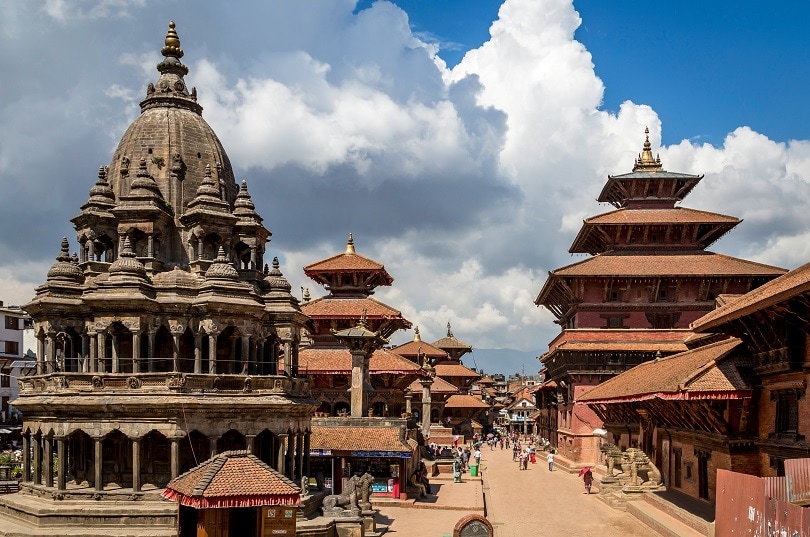
At a distance of 5 km from Kathmandu, the town of Patan is surrounded by four stupas erected by Emperor Ashoka in the third century B.C. Also, known as Lalitpur, the Patan Durbar Square is one among the UNESCO World Cultural Heritage Sites in Nepal. A marvel of Newar architecture, it has a Square floor that is tiled with red bricks. Housing many temples and idols, it also holds old Newari residential houses.
With a rich and diverse history, Patan always played a huge role in the cultural and political history of Nepal throughout the centuries.
How to get here from Kathmandu:
Several buses connect various parts of Kathmandu to Patan Durbar Square. Taxi fares range around 400 NPR.
Entrance Fee:
Foreign Nationals including Chinese – 1000 NPR
SAARC nationals – 250 NPR
Key Attractions:
Krishna Temple, Kumbeshwor Temple, Golden Temple, Jagat Narayan Temple, Vishwanath Temple, Mahaboudha Temple, Bhimsen Temple
Big Bell, Mani Mantap
Pillar of Yognarendra Malla
Café Pagoda
7. Swayambhunath Stupa
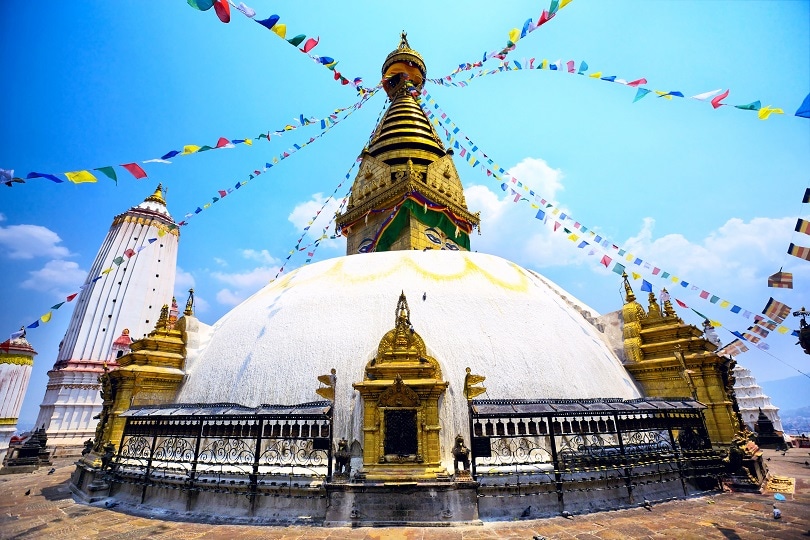
Located at a mere distance of 3 km from the capital city, this is another of Nepal’s UNESCO World Cultural Heritage Sites. It is said that a millennium ago, this area was an island and King Manadeva built a stupa here around 460 A.D. It’s also known as the Monkey Temple for the primate population in and around the temple complex.
Today, the stupa has a pinnacle made of copper with a conical spire. The lower hemisphere is made of clay and brick and has Lord Buddha’s eyes adorned on all four corners. The stupa offers sweeping views of the entire valley of Kathmandu.
How to get here from Kathmandu:
Taxis take around 10 to 15 minutes from Thamel to this stupa, and the average cost is around 150 NPR.
Entrance Fee:
Foreign Nationals including Chinese – 200 NPR
SAARC Nationals – 50 NPR
Nepalese – Free
Key Attractions:
Sleeping Buddha
Dewa Dharma Monastery
Vajra thunderbolt on the eastern side of the Stupa
Harati temple, dedicated to the Goddess of Children
8. Kathmandu Durbar Square
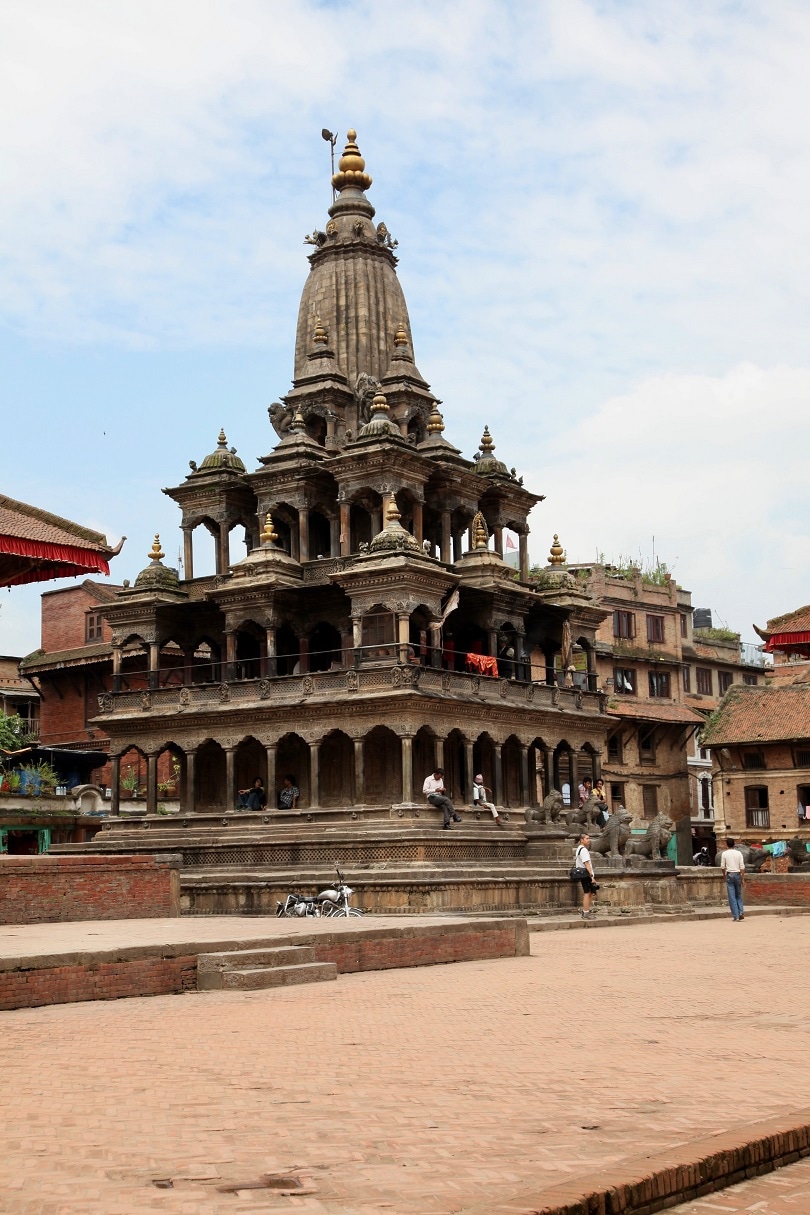
This is one of the must-see Places of Historical Importance in Nepal and a UNESCO World Cultural Heritage Site. Located in the heart of Kathmandu, your trip to Nepal is incomplete without stepping into this massive complex.
It’s a live museum and gives you a glimpse into the local way of life. Filled with popular shrines and temples that demonstrate the ancient Newari architecture, it’s a great place to start your trip to Nepal.
How to get here:
It’s easily accessible by bus, taxis from all areas of Kathmandu.
Entrance Fee:
This includes tickets to both the Durbar Square and the Tribhuvan Museum.
-
- Foreign Nationals including Chinese – 1000 NPR
- SAARC National – 150 NPR
- Nepalese – Free
Key Attractions:
Kasthamandap – a wooden pavilion that holds ancient and rare images of Lord Gorakhnath.
Trailokya Narayan Temple – The world’s largest temple dedicated to Lord Vishnu.
Sadly, these structures were completely destroyed in the 2015 earthquake.
Shiva Parvati temple, Taleju temple (entry restricted), Kumari Bahal, Basantapur Tower, Gaddi Baihak.
9. Janakpur
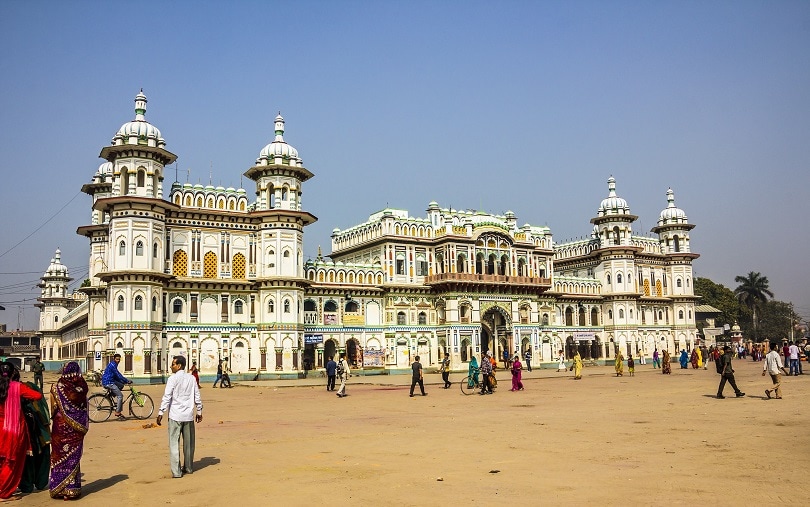
Located in central Nepal, Janakpur was the capital of the ancient kingdom of Mithila, better known as the birthplace of Sita and the city where Lord Ram wed her. Centuries later, the Maithili culture is still evident in this city, which remains untouched by modernity.
Thousands of Hindu pilgrims visit Janaki Mandir every year on the Vivah Panchami festival, the anniversary of the wedding of the mythical couple held in November or early December every year. The massive three-story temple complex with over 60 rooms is the crowning glory of Janakpur. It’s considered one of the top 10 historical places in Nepal.
How to get here from Kathmandu:
The drive from Kathmandu to Janakpur takes around 10 hours by road and several buses connect these two cities. Alternatively, you can take a domestic flight that takes approximately 40 minutes.
Entrance Fee:
No entry charges for the temple complex.
Key Attractions:
The 19th-century marble temple is the biggest temple in all of Nepal.
Over a hundred pounds and pools scattered around the city.
10. Muktinath Temple
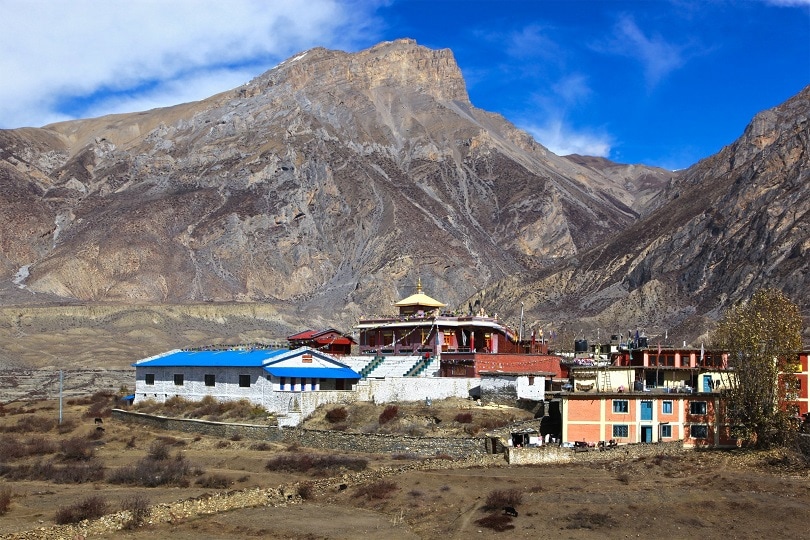
Situated at a height of 3710 m above sea-level, this is one of the holiest places for both Hindus and Buddhists. The name Muktinath literally means, “Place of Salvation.” The temple is a small structure and contains an idol of Lord Vishnu, as Mukti Narayana. This pilgrimage site is an excellent example of how two religions can share a holy site in harmony.
According to Hindu philosophy, a visit to this temple puts an end to the cycle of birth and rebirth. It will help you attain true salvation, where you become one with the divine.
How to get here from Kathmandu:
By Road – It takes around two nights. The ideal route is Kathmandu – Pokhara – Jomsom and then Muktinath.
By Flights – There are no direct flights connecting Jomsom (the nearest airport) to Kathmandu. Take a flight from Kathmandu to Pokhara and then to Jomsom. Flights to Jomsom operate only in the mornings and that too, only if the weather is clear.
By Helicopter – You can hire a helicopter to take you from Kathmandu to Muktinath. The journey takes around 1.5 hours.
Key Attractions:
Muktidhara – 108 frozen waterspouts in the backyard of the temple, that flow continuously, irrespective of the weather. Taking a dip in these spouts and the two ponds of the temple complex is believed to bring you salvation.
Gumba Samba – a monastery of Tibetan origin.
Go Beyond
If you have more time on your hands, then you can also cover other historical places in Nepal in your itinerary like-, Mahendra Gufa- a limestone cave near Pokhara, 55 Window Palace in Bhaktapur, Makwanpur Gadhi at Makwanpur district and Thamel area in Kathmandu. Explore this beautiful and most amazing country, rich in culture, beauty and heritage.
11. Mustang Caves
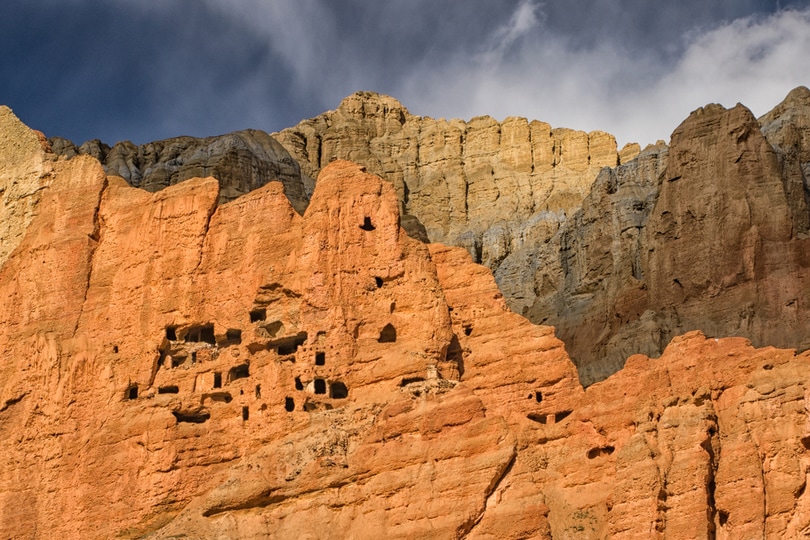
Mustang Caves are also known as the Sky Caves of Nepal, the amazing thing about these caves are that these caves are the collection of 10,000 man-made caves which is located into the sides of the beautiful valleys of Mustang district.
After many years of digging and experiments, archaeologists and researchers found preserved human bodies and skeletons which is around 2000 to 3000 years old. They found many more precious objects like sculptures, manuscripts, artefacts and Buddhist paintings which belong to the 12th to 14th century.
How to get here from Kathmandu
To reach mustang first you have to reach Pokhara by tourist bus or flight. It is up to you how you want to travel and reach Mustang. After reaching Pokhara, either take a Jeep or a flight to reach Jomsom the starting point of Mustang trekking place. If you are a lover of nature then you should go by the jeep to enjoy the immense beauty of this place.
Entrance Fee
- Foreigners – 2000 NPR
- SAARC Nations – 200 NPR
- Nepalese – Free
Key Attractions
- Royal Palace of Lo Manthang it is one of the prime tourist spots and the is the capital of the Upper Mustang region which is the city of Lo Manthang. There are 3 monasteries in the middle of the walled city. Far from the busy city life, this place is totally embracing nature, it showcases the amazing ancient Tibetan Buddhist traditions and customs.
- The landscape of Chooser & Cora La, close to nature and you can experience the sky caves, grand rock formation and monasteries.
- Luri Gimba & Ghar Ghumba, it has some of the finest and a different kind of Buddhism ancient monasteries.
- The scenery at Tsarang & Dhakmar, the most important attraction is the Red Cliff with caves which is a nearby wall of Dhakmar. The other two attractions are Damodar Kunda & Saligram Sila and Lower Mustang & Muktinath Temple
12. Janki Mandir
Janki Mandir as the name suggests, it is dedicated to Goddess Sita in the Mithila region. It is a great example of Hindu and Koiri, in Nepali architecture. The architecture of this temple is an amazing work and portrays the koiri culture really beautifully.
It is built in the mixed style of Mughal and koiri domes. This temple was built by the Queen Vrisha Bhanu of Tikamgarh, India in 1910 AD
How to get here from Kathmandu
You can travel either by bus, car or train. It’s your choice which road you want to take as per your convenience. If you are a nature then maybe a bus or car will do great but if you want to just relax and reach then a bus is a great option.
Entrance Fee
There is no entrance fee for this temple, you can explore and be there for as long as you want.
Key Attractions
- Explore the beautiful Janki Temple, as the architecture and the paintings are worth watching and observe the beauty of this place.
- You can explore the palace of Janakpur as the historical facts are so beautiful and the Ramayan period facts and the famous palace of Videhi should be worth watching.
13. Kopan Monastery
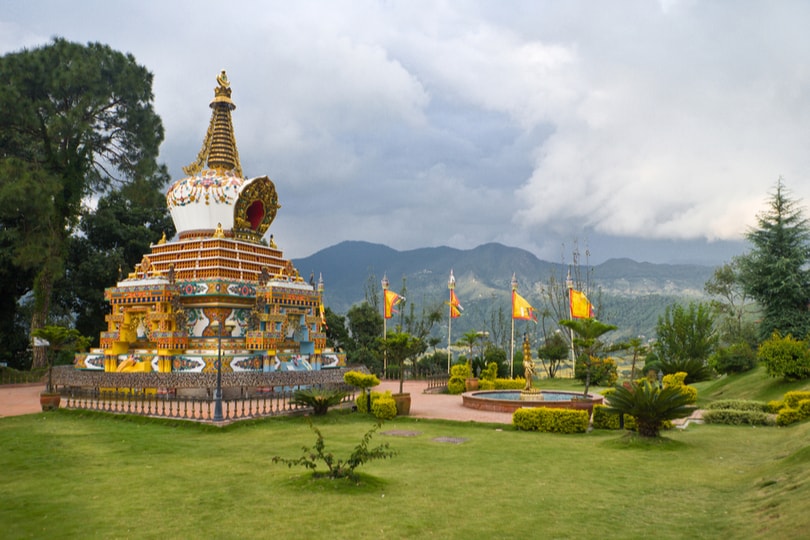
Kopan monastery is one of the most famous monasteries in Nepal. Its name is kept from the hills on which it is built. It is a Tibetan monastery, near Boudhanath which is on the outskirts of Kathmandu.
It is famous for its teachings of Buddhism to the coming foreigners. The place is lit with a positive vibe and will make you feel relaxed and calm. Monasteries are really a great place to live or to explore as you learn a lot of new things.
How to get here from Kathmandu
You can travel by car and reach this place as this place takes only 21 mins from Kathmandu. The natural vibe of this place will fill you with a different kind of energy and you will feel the happiness from inside.
Entrance Fee
There is no entrance fee, but if you want to stay in this monastery then you have to pay. The cost of staying is between 7USD and 20USD. And you will get three vegetarian meals which are included in the cost.
Key Attractions
- You can visit the other monasteries as well which is near Kopan monastery and see the view of the amazing nature.
You can meditate in the beautiful gardens, spin the amazing prayer wheels, explore some stupas and listen to the teachings from the monks.
14. Complex of Ruru Kshetra
This place is a really famous place for the Hindus as it is one of the most important Hindu pilgrimage and cremation place as well where you can do all the Hindu rituals.
The adjacent settlement of Ridi has retained its medieval character and the architecture carries the historic really well. To preserve the heritage of this place, fairs and festivals are celebrated regularly, this makes this place more vibrant.
How to get here from Kathmandu
You can travel by Road, easily from the car as it is not so far away and while enjoying the beautiful natural view, you will reach this place in 2 to 3 hours.
Entrance Fee
The entrance fee is 1,000 NPR for all the foreigners to visit this beautiful and spiritual place in Nepal.
Key attractions
- The ancient medieval architecture which is still protected is the greatest attraction of this beautiful place.
- Another thing is the natural surroundings which will give you a heavenly touch and culture.
15. Sagarmatha National Park
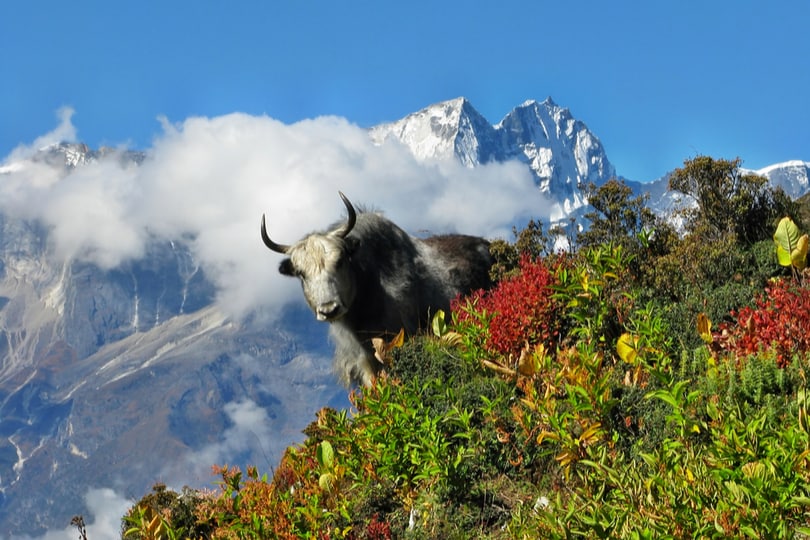
This national park is in the lap of the Himalayas of eastern Nepal controlled by the Mount Everest. The national park was established in 1976. Most amazing, in 1979 it became the country’s first national park which was listed in the National World Heritage Site.
In the east of Sagarmatha national park lies Makalu Barun National park and in the south, it reaches Dudh Koshi river. The place is a perfect example of heaven on earth. Beautiful mountains and nature showering their blessing of this place.
How to get here from Kathmandu
To reach this beautiful place is not that easy. You have to take 25mins of flight from Kathmandu to Lukla. There you have to trek and go to the national park but it will take 2 days to reach your destination.
Entrance fee
Foreigners – 3000 INR
SAARC Nationals – 1500 INR
Locals from Nepal – 25 INR
Key Attractions
- The beautiful bio- reserve in the lap of the mountains covered with snow.
- Rare species like snow leopard and the lesser panda are found in the park.
- Another interesting thing is the Sherpas, which will make your day more adventurous with their amazing and different culture, this increases further interest in this place.
- Top 16 Things to do in Kolkata in 24-hours - July 25, 2019
- Savour These Delicacies While in Bali for a True Gastronomical Treat! - May 29, 2019
- A Seasonal Guide to Sri Lanka – The Pearl of the Indian Ocean 2019 & 2020 - May 24, 2019
- Six Experiences You Mustn’t Miss in Sri Lanka for A Fabulous Trip! - May 24, 2019
- 5 Bazaar Ramadan terbaik di Kuala Lumpur. - May 15, 2019
- Planning to Visit Ladakh? Here is a Seasonal Guide to Help You Plan Your Trip - May 8, 2019
- Visit These Places in Bali For an Exciting Vacation in The Tropical Island! - May 7, 2019
- 8 Best Places to Spend Your Vacation in the Hills of Himachal Pradesh - April 17, 2019
- Places to Visit in Thailand - April 16, 2019
- Want to Visit Bali at Minimum Cost? Follow Our Guide to Travel Bali on a Budget! - April 12, 2019

